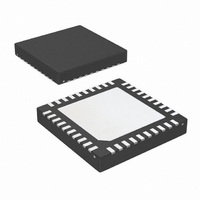LP3971SQ-2G16/NOPB National Semiconductor, LP3971SQ-2G16/NOPB Datasheet - Page 46

LP3971SQ-2G16/NOPB
Manufacturer Part Number
LP3971SQ-2G16/NOPB
Description
IC PMU FOR APPL PROCESSORS 40LLP
Manufacturer
National Semiconductor
Series
PowerWise®r
Datasheet
1.LP3971SQ-B510NOPB.pdf
(50 pages)
Specifications of LP3971SQ-2G16/NOPB
Applications
Processor
Current - Supply
60µA
Voltage - Supply
2.7 V ~ 5.5 V
Operating Temperature
-40°C ~ 85°C
Mounting Type
Surface Mount
Package / Case
40-LLP
Lead Free Status / RoHS Status
Lead free / RoHS Compliant
Other names
LP3971SQ-2G16
LP3971SQ-2G16
LP3971SQ-2G16TR
LP3971SQ-2G16
LP3971SQ-2G16TR
www.national.com
Model
FDSE0312-2R2M
DO1608C-222
BUCK CONSIDERATIONS
Inductor Selection
There are two main considerations when choosing an induc-
tor; the inductor should not saturate, and the inductor current
ripple is small enough to achieve the desired output voltage
ripple. Different saturation current rating specs are followed
by different manufacturers so attention must be given to de-
tails. Saturation current ratings are typically specified at 25°C
so ratings at max ambient temperature of application should
be requested from manufacturer.
There are two methods to choose the inductor saturation cur-
rent rating.
Method 1
The saturation current is greater than the sum of the maxi-
mum load current and the worst case average to peak induc-
tor current. This can be written as
• I
• I
• V
• L: Min inductor value including worst case tolerances (30%
drop can be considered for method 1)
• f: Minimum switching frequency (1.6 MHz)
• V
Method 2
A more conservative and recommended approach is to
choose an inductor that has saturation current rating greater
than the max current limit of TBD mA.
Output Capacitor Selection
Use a 10 μF, 6.3V ceramic capacitor. Use X7R or X5R types,
do not use Y5V. DC bias characteristics of ceramic capacitors
must be considered when selecting case sizes like 0805 and
0603. DC bias characteristics vary from manufacturer to man-
ufacturer and dc bias curves should be requested from them
as part of the capacitor selection process. The output filter
capacitor smooths out current flow from the inductor to the
load, helps maintain a steady output voltage during transient
load changes and reduces output voltage ripple. These ca-
pacitors must be selected with sufficient capacitance and
sufficiently low ESR to perform these functions.
The output voltage ripple is caused by the charging and dis-
charging of the output capacitor and also due to its ESR and
can be calculated as:
RIPPLE
OUTMAX
IN
OUT
: Maximum input voltage in application
: Output voltage
: Average to peak inductor current
: Maximum load current (1500 mA)
Vendor
Toko
Coilcraft
TABLE 1. Suggested Inductors and Their Suppliers
Dimensions LxWxH (mm)
46
A 2.2 μH inductor with a saturation current rating of at least
TBD mA is recommended for most applications. The
inductor’s resistance should be less than 0.3Ω for a good ef-
ficiency. Table 1 lists suggested inductors and suppliers. For
low-cost applications, an unshielded bobbin inductor could be
considered. For noise critical applications, a toroidal or shield-
ed bobbin inductor should be used. A good practice is to lay
out the board with overlapping footprints of both types for de-
sign flexibility. This allows substitution of a low-noise shielded
inductor, in the event that noise from low-cost bobbin models
is unacceptable.
Input Capacitor Selection
A ceramic input capacitor of 10 μF, 6.3V is sufficient for most
applications. Place the input capacitor as close as possible to
the V
proved input voltage filtering. Use X7R or X5R types, do not
use Y5V. DC bias characteristics of ceramic capacitors must
be considered when selecting case sizes like 0805 and 0603.
The input filter capacitor supplies current to the PFET switch
of the converter in the first half of each cycle and reduces
voltage ripple imposed on the input power source. A ceramic
capacitor’s low ESR provides the best noise filtering of the
input voltage spikes due to this rapidly changing current. Se-
lect a capacitor with sufficient ripple current rating. The input
current ripple can be calculated as:
The worst case is when V
Voltage peak-to-peak ripple due to ESR can be expressed as
follows
Because these two components are out of phase the rms val-
ue can be used to get an approximate value of peak-to-peak
ripple.
Voltage peak-to-peak ripple, root mean squared can be ex-
pressed as follows
Note that the output voltage ripple is dependent on the induc-
tor current ripple and the equivalent series resistance of the
output capacitor (R
The R
dependent); make sure the value used for calculations is at
the switching frequency of the part.
3.0 x 3.0 x 1.2
6.6 x 4.5 x 1.8
IN
ESR
pin of the device. A larger value may be used for im-
is frequency dependent (as well as temperature
V
PP-ESR
ESR
).
= (2 * I
IN
= 2 * V
RIPPLE
OUT
) * R
D.C.R (Typ)
ESR
160 mΩ
80 mΩ











